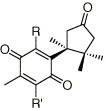The Hare’s foot inkcap, Coprinopsis lagopus (Fr.) Redhead, Vilgalys, Moncalvo. This delicate, short-lived species often completes the fruitbody part of its life cycle in under 48 hours.
Classification
Kingdom Fungi
Phylum Basidiomycota
Class Basidiomycetes
Order Agaricales
Family Agaricaceae
Genus Coprinus
Synonyms
Agaricus lagopus Fr.
Syst. mycol. (Lundae) 1: 312 (1821)
Coprinus lagopus (Fr.) Fr.
Epicr. syst. mycol. (Upsaliae): 250 (1838)
Coprinus lagopus (Fr.) Fr.
Epicr. syst. mycol. (Upsaliae): 250 (1838) f. lagopus
Coprinus lagopus f. macrospermus Romagn.
Revue Mycol., Paris 10: 89 (1945)
Coprinus lagopus (Fr.) Fr.
Epicr. syst. mycol. (Upsaliae): 250 (1838) var. lagopus
Common names
Hare’s foot inkcap
Woolly inkcap
Fairies shelter
Description
Cap: up to 3.5 x 2.0 cm as primordia, up to 4 cm diameter at maturity, first ellipsoid, pale to very dark-brown at center beneath the whitish to silvery grey veil, paler to margin, expanding to conical, then to convex or applanate, finally planar with revolute margin.
Veil: at first whitish, then silvery grey or pale grey to grey-brown, covering entire pileus, splitting up into hairy or fibrillose, often pointed and adpressed or – especially in center – recurved flocks, the tips becoming brown on drying.
Gills: free, thin, rather crowded, first white, soon grayish brown to blackish, deliquescing in age, especially in wet weather.
Stem: 5-10 cm x 0.2-0.5 cm thick; whitish, somewhat tapering towards apex, up to 0.8 cm wide at clavate to bulbous base, hollow, hairy flocculose over the whole surface but especially at lower part, becoming glabrous with age.
Spore print: violet-black.
Spores: 10-14 x 6-8.5 µm, ellipsoid or ovoid, with rounded base and apex, dark red-brown, nonamyloid.
Edibility: unknown.
Habitat: solitary or arranged in bundles, on wood chips, compost heaps, or vegetable refuse, from autumn to mid-winter. Widespread globally.
Description adapted from Bas, 1988, pp. 65-66, as well as Keirle et al., 2004.
Bioactive compounds
A β-glucan polysaccharide was isolated from the purified mycelial walls of C. lagopus. Methylation analysis revealed that the glucan contains β-1,3-linked glucose units with about 14% of the sugars having 1,6-linked branch points (Schaefer, 1977).
Mycelial extracts were shown to agglutinate erythrocytes of several animal species, including humans (Banerjee et al., 1982). Agglutination was partially inhibited nonspecifically by high concentrations of of monosaccharides glucose, galactose, mannose, fucose and rhamnose.
Medicinal properties
Antitumor activity
Polysaccharides extracted from the mycelial culture of C. lagopus and administered intraperitoneally into white mice at a dosage of 300 mg/kg inhibited the growth of Sarcoma 180 and Ehrlich solid cancers by 100% and 90%, respectively (Ohtsuka et al., 1973).
The sesquiterpenoid benzoquinone molecules lagopodins A (2-methyl-5- (1,2,2-trimethyl- 4-oxocyclopentyl)- 2,5-cyclohexadiene- 1,4-dione) and B (6-hydroxy-2-methyl-5- (1,2,2-trimethyl-4-oxocyclopentyl)- 2,5-cyclohexadiene-1,4-dione), isolated from C. lagopus, are active as antibiotics against Gram + bacteria (Bu’lock and Darbyshire, 1978).

When R and R’ are H, its lagopodin A, when R=OH and R’=H, its lagopodin B.
Coletto et al. (2000) also reported the mycelia and culture filtrate of C. lagopus to have activity against both Gram + and Gram – bacteria.

My name is Austin Collins.
I've dedicated my life to Mushrooms.
I believe Mushrooms are the best kept secret when it comes to health and well being.
For that reason, I would like to share a company with you that in my opinion makes the best mushroom products on the market.
The company is called Noomadic Herbals, my favorite supplement they make is called "Mushroom Total".
I take their products every day and they have helped me think better and have more energy. Give them a try.
-Austin
Links
Kees Uljé Coprinus site
Fungi of Poland
You can see a gallery of photos at the Mushroom Observer website, and also at BioPix.
References
Banerjee PC, Ghosh AK, Sengupta S.
Hemagluttinating activity in extracts of mycelia from submerged mushroom cultures.
Appl Environ Microbiol. 1982 44(4):1009-11.
Bas C. (1988).
Flora Agaricina Neerlandica: Critical monographs on families of agarics and boleti occurring in the Netherlands. Vol 6. (ME Noordeloos, TH Kuyper, EC Vellinga, Eds.).
Taylor and Francis.
Bollinger P. (1965).
Über die Konstitution und Konfiguration der Lagopodine A, B, und C.
Ph.D. Thesis, ETH, Zurich.
Bu’lock JD, Darbyshire J.
Lagopodin metabolites and artifacts in cultures of Coprinus.
Phytochem. 1976 15(12):2004.
Bycroft BW. (1988).
Dictionary of Antibiotics and Related Substances.
Chapman & Hall/CRC Press. 962 pp.
Coletto B, Ausilia M, Barbara S.
Basidiomiceti in relazione all’antibiosi. XIII. Attivita antibiotica dei miceli e dei liquidi colturali.
[Antibiotic activity in Basidiomycetes. XIII. Antibiotic activity of mycelia and cultural filtrates]
Allionia (Turin). 2000 37:253-5.
Keirle MR, Hemmes DE, Desjardin DE.
Agaricales of the Hawaiian Islands. 8. Agaricaceae: Coprinus and Podaxis; Psathyrellaceae: Coprinopsis, Coprinellus and Parasola.
Fungal Diversity. 2004 15:33-124.
PDF
Ohtsuka S, Ueno S, Yoshikumi C, Hirose F, Ohmura Y, Wada T, Fujii T, Takahashi E.
Polysaccharides having an anticarcinogenic effect and a method of producing them from species of Basidiomycetes.
UK Patent 1331513, 26 September 1973.
Schaefer HP.
Alkali-soluble polysaccharide from cell-walls of Coprinus lagopus.
Arch. Microbiol. 1977 113(1-2):79-82.




Hare’s foot inkcap is edible?
The opposite! It is inedible.